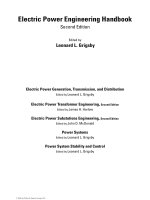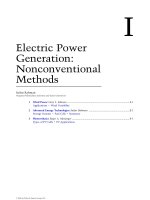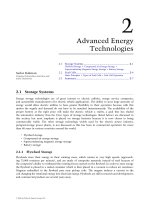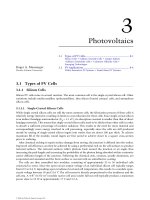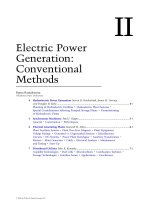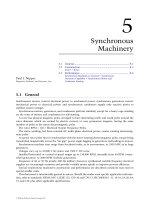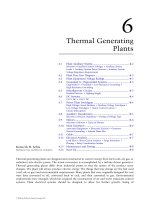Electrical machinery and power system fundamentals
Bạn đang xem bản rút gọn của tài liệu. Xem và tải ngay bản đầy đủ của tài liệu tại đây (3.09 MB, 337 trang )
Instructor’s Manual
to accompany
Chapman
Electric Machinery and Power System Fundamentals
First Edition
Stephen J. Chapman
BAE SYSTEMS Australia
i
Instructor’s Manual to accompany Electric Machinery and Power System Fundamentals, First Edition
Copyright 2001 McGraw-Hill, Inc.
All rights reserved. Printed in the United States of America. No part of this book may be used or reproduced in
any manner whatsoever without written permission, with the following exception: homework solutions may be
copied for classroom use.
ISBN: ???
ii
TABLE OF CONTENTS
1
2
3
4
5
6
7
8
9
10
11
12
13
Preface
Mechanical and Electromagnetic Fundamentals
iv
1
Three-Phase Circuits
Transformers
23
27
AC Machine Fundamentals
Synchronous Machines
Parallel Operation of Synchronous Generators
66
69
103
Induction Motors
DC Motors
Transmission Lines
114
148
178
Power System Representation and Equations
193
205
256
285
Introduction to Power-Flow Studies
Symmetrical Faults
Unsymmetrical Faults
iii
PREFACE
TO THE INSTRUCTOR
This Instructor’s Manual is intended to accompany the third edition of Electric Machinery and Power System
Fundamentals. To make this manual easier to use, it has been made self-contained. Both the original problem
statement and the problem solution are given for each problem in the book. This structure should make it easier to
copy pages from the manual for posting after problems have been assigned.
Many of the problems in Chapters 2, 5, 6, and 9 require that a student read one or more values from a
magnetization curve. The required curves are given within the textbook, but they are shown with relatively few
vertical and horizontal lines so that they will not appear too cluttered. Electronic copies of the corresponding
open-circuit characteristics, short-circuit characteristics, and magnetization curves as also supplied with the book.
They are supplied in two forms, as MATLAB MAT-files and as ASCII text files. Students can use these files for
electronic solutions to homework problems. The ASCII files are supplied so that the information can be used with
non-MATLAB software.
The solutions in this manual have been checked carefully, but inevitably some errors will have slipped through. If
you locate errors which you would like to see corrected, please feel free to contact me at the address shown below,
or at my email address I greatly appreciate your input! My physical and email
addresses may change from time to time, but my contact details will always be available at the book’s Web site,
which is />Thank you.
Stephen J. Chapman
Melbourne, Australia
August 16, 2001
Stephen J. Chapman
276 Orrong Road
Caulfield North, VIC 3161
Australia
Phone +61-3-9527-9372
iv
Chapter 1: Mechanical and Electromagnetic Fundamentals
1-1.
A motor’s shaft is spinning at a speed of 1800 r/min. What is the shaft speed in radians per second?
SOLUTION The speed in radians per second is
1 min 2π rad
= 188.5 rad/s
60 s 1 r
ω = (1800 r/min)
1-2.
A flywheel with a moment of inertia of 4 kg ⋅ m2 is initially at rest. If a torque of 5 N ⋅ m
(counterclockwise) is suddenly applied to the flywheel, what will be the speed of the flywheel after 5 s?
Express that speed in both radians per second and revolutions per minute.
SOLUTION The speed in radians per second is:
5 N ⋅m
τ
(5 s ) = 6 .25 rad/s
t =
4 kg ⋅ m 2
J
ω =α t =
The speed in revolutions per minute is:
1 r 60 s
n = ( 6.25 rad/s)
= 59.7 r/min
2π rad 1 min
1-3.
A force of 5 N is applied to a cylinder, as shown in Figure P1-1. What are the magnitude and direction of
the torque produced on the cylinder? What is the angular acceleration α of the cylinder?
SOLUTION The magnitude and the direction of the torque on this cylinder is:
τ ind = rF sin θ , CCW
τ ind = (0.5 m )(5 kg ⋅ m 2 ) sin 40° = 1.607 N ⋅ m, CCW
1-4.
A motor is supplying 70 N ⋅ m of torque to its load. If the motor’s shaft is turning at 1500 r/min, what is
the mechanical power supplied to the load in watts? In horsepower?
SOLUTION The mechanical power supplied to the load is
1 min 2π rad
P = τω = (70 N ⋅ m )(1500 r/min)
= 11,000 W
60 s 1 r
1 hp
P = (11,000 W )
= 14.7 hp
746 W
1-5.
A ferromagnetic core is shown in Figure P1-2. The depth of the core is 5 cm. The other dimensions of
the core are as shown in the figure. Find the value of the current that will produce a flux of 0.003 Wb.
1
With this current, what is the flux density at the top of the core? What is the flux density at the right side
of the core? Assume that the relative permeability of the core is 1000.
SOLUTION There are three regions in this core. The top and bottom form one region, the left side forms a
second region, and the right side forms a third region. If we assume that the mean path length of the flux
is in the center of each leg of the core, and if we ignore spreading at the corners of the core, then the path
lengths are l1 = 2(27.5 cm) = 55 cm, l 2 = 30 cm, and l3 = 30 cm. The reluctances of these regions are:
0.55 m
l
l
=
=
= 58.36 kA ⋅ t/Wb
−7
µA µ r µ o A (1000)(4π × 10 H/m )(0.05 m )(0.15 m )
0.30 m
l
l
R2 =
=
=
= 47.75 kA ⋅ t/Wb
−7
µA µ r µ o A (1000)(4π × 10 H/m )(0.05 m )(0.10 m )
0.30 m
l
l
R3 =
=
=
= 95.49 kA ⋅ t/Wb
−7
µA µ r µ o A (1000)(4π × 10 H/m )(0.05 m )(0.05 m )
R1 =
The total reluctance is thus
RTOT = R1 + R2 + R3 = 58.36 + 47.75 + 95.49 = 201.6 kA ⋅ t/Wb
and the magnetomotive force required to produce a flux of 0.003 Wb is
F = φ R = ( 0.003 Wb )( 201.6 kA ⋅ t/Wb ) = 605 A ⋅ t
and the required current is
i=
F 605 A ⋅ t
=
= 1.21 A
N
500 t
The flux density on the top of the core is
B=
φ
A
=
0.003 Wb
= 0.4 T
(0.15 m )(0.05 m )
The flux density on the right side of the core is
B=
1-6.
φ
A
=
0.003 Wb
= 1.2 T
(0.05 m )(0.05 m )
A ferromagnetic core with a relative permeability of 2000 is shown in Figure P1-3. The dimensions are
as shown in the diagram, and the depth of the core is 7 cm. The air gaps on the left and right sides of the
2
core are 0.050 and 0.070 cm, respectively. Because of fringing effects, the effective area of the air gaps is
5 percent larger than their physical size. If there are 300 turns in the coil wrapped around the center leg of
the core and if the current in the coil is 1.0 A, what is the flux in each of the left, center, and right legs of
the core? What is the flux density in each air gap?
SOLUTION This core can be divided up into five regions. Let R1 be the reluctance of the left-hand portion
of the core, R2 be the reluctance of the left-hand air gap, R3 be the reluctance of the right-hand portion
of the core, R4 be the reluctance of the right-hand air gap, and R5 be the reluctance of the center leg of
the core. Then the total reluctance of the core is
RTOT = R5 +
(R1 + R2 )(R3 + R4 )
R1 + R2 + R3 + R4
l1
1.11 m
R1 =
=
= 90.1 kA ⋅ t/Wb
−7
µ r µ 0 A1 (2000)(4π × 10 H/m )(0.07 m )(0.07 m )
l
0.0005 m
R2 = 2 =
= 77.3 kA ⋅ t/Wb
−7
µ 0 A2 (4π × 10 H/m )(0.07 m )(0.07 m )(1.05)
l3
1.11 m
R3 =
=
= 90.1 kA ⋅ t/Wb
−7
µ r µ 0 A3 (2000)(4π × 10 H/m )(0.07 m )(0.07 m )
l
0.0007 m
R4 = 4 =
= 108.3 kA ⋅ t/Wb
−7
µ 0 A4 (4π × 10 H/m )(0.07 m )(0.07 m )(1.05)
l5
0.37 m
R5 =
=
= 30.0 kA ⋅ t/Wb
−7
µ r µ 0 A5 (2000)(4π × 10 H/m )(0.07 m )(0.07 m )
The total reluctance is
RTOT = R5 +
(R1 + R2 )(R3 + R4 ) = 30.0 + (90.1 + 77.3)(90.1 + 108.3) = 120.8 kA ⋅ t/Wb
R1 + R2 + R3 + R4
90.1 + 77.3 + 90.1 + 108.3
The total flux in the core is equal to the flux in the center leg:
φ center = φ TOT =
(300 t )(1.0 A ) = 0.00248 Wb
F
=
RTOT 120.8 kA ⋅ t/Wb
The fluxes in the left and right legs can be found by the “flux divider rule”, which is analogous to the
current divider rule.
3
φ left =
(R3 + R4 )
R1 + R2 + R3 + R4
φ TOT =
(R1 + R2 )
φ right =
R1 + R2 + R3 + R4
(90.1 + 108.3)
90.1 + 77.3 + 90.1 + 108.3
φ TOT =
(0.00248 Wb) = 0.00135 Wb
(90.1 + 77.3)
90.1 + 77.3 + 90.1 + 108.3
(0.00248 Wb) = 0.00113 Wb
The flux density in the air gaps can be determined from the equation φ = BA :
Bleft =
φ left
Aeff
Bright =
1-7.
=
φ right
Aeff
0.00135 Wb
= 0.262 T
(0.07 cm )(0.07 cm )(1.05)
=
0.00113 Wb
= 0.220 T
(0.07 cm )(0.07 cm )(1.05)
A two-legged core is shown in Figure P1-4. The winding on the left leg of the core (N1) has 600 turns,
and the winding on the right (N2) has 200 turns. The coils are wound in the directions shown in the
figure. If the dimensions are as shown, then what flux would be produced by currents i1 = 0.5 A and i2 =
1.00 A? Assume µr = 1000 and constant.
SOLUTION The two coils on this core are would so that their magnetomotive forces are additive, so the
total magnetomotive force on this core is
FTOT = N 1i1 + N 2 i2 = (600 t )(0.5 A ) + (200 t )(1.0 A ) = 500 A ⋅ t
The total reluctance in the core is
RTOT =
l
µ r µ0 A
=
2.60 m
= 92.0 kA ⋅ t/Wb
(1000)(4π × 10 H/m )(0.15 m )(0.15 m )
−7
and the flux in the core is:
φ=
FTOT
500 A ⋅ t
=
= 0.0054 Wb
RTOT 92.0 kA ⋅ t/Wb
4
1-8.
A core with three legs is shown in Figure P1-5. Its depth is 5 cm, and there are 200 turns on the leftmost
leg. The relative permeability of the core can be assumed to be 1500 and constant. What flux exists in
each of the three legs of the core? What is the flux density in each of the legs? Assume a 4% increase in
the effective area of the air gap due to fringing effects.
SOLUTION This core can be divided up into four regions. Let R1 be the reluctance of the left-hand
portion of the core, R2 be the reluctance of the center leg of the core, R3 be the reluctance of the center
air gap, and R4 be the reluctance of the right-hand portion of the core. Then the total reluctance of the
core is
RTOT = R1 +
l1
(R2 + R3 )R4
R 2 + R3 + R 4
1.08 m
= 127.3 kA ⋅ t/Wb
µ r µ 0 A1 (1500)(4π × 10 H/m )(0.09 m )(0.05 m )
l2
0.34 m
R2 =
=
= 24.0 kA ⋅ t/Wb
−7
µ r µ 0 A2 (1500)(4π × 10 H/m )(0.15 m )(0.05 m )
l
0.0004 m
R3 = 3 =
= 40.8 kA ⋅ t/Wb
−7
µ 0 A3 (4π × 10 H/m )(0.15 m )(0.05 m )(1.04 )
l4
1.08 m
R4 =
=
= 127.3 kA ⋅ t/Wb
−7
µ r µ 0 A4 (1500)(4π × 10 H/m )(0.09 m )(0.05 m )
R1 =
=
−7
The total reluctance is
RTOT = R1 +
(R2 + R3 )R4
R 2 + R3 + R 4
= 127.3 +
(24.0 + 40.8)127.3
24.0 + 40.8 + 127.3
= 170.2 kA ⋅ t/Wb
The total flux in the core is equal to the flux in the left leg:
φ left = φ TOT =
(200 t )(2.0 A ) = 0.00235 Wb
F
=
RTOT 170.2 kA ⋅ t/Wb
The fluxes in the center and right legs can be found by the “flux divider rule”, which is analogous to the
current divider rule.
φ center =
φ right =
R4
127.3
(0.00235 Wb) = 0.00156 Wb
φ TOT =
R2 + R3 + R4
24.0 + 40.8 + 127.3
R2 + R3
24.0 + 40.8
(0.00235 Wb) = 0.00079 Wb
φ TOT =
24.0 + 40.8 + 127.3
R 2 + R3 + R 4
5
The flux density in the legs can be determined from the equation φ = BA :
Bleft =
φ left
A
Bcenter =
Bright =
1-9.
=
0.00235 Wb
= 0.522 T
(0.09 cm )(0.05 cm )
φ center
A
φ left
A
=
=
0.00156 Wb
= 0.208 T
(0.15 cm )(0.05 cm )
0.00079 Wb
= 0.176 T
(0.09 cm )(0.05 cm )
A wire is shown in Figure P1-6 which is carrying 2.0 A in the presence of a magnetic field. Calculate the
magnitude and direction of the force induced on the wire.
SOLUTION The force on this wire can be calculated from the equation
F = i (l × B ) = ilB = (2 A )(1 m )(0.35 T ) = 0.7 N, into the page
1-10.
The wire shown in Figure P1-7 is moving in the presence of a magnetic field. With the information given
in the figure, determine the magnitude and direction of the induced voltage in the wire.
SOLUTION The induced voltage on this wire can be calculated from the equation shown below. The
voltage on the wire is positive downward because the vector quantity v × B points downward.
eind = ( v × B ) ⋅ l = vBl cos 45° = ( 6 m/s )( 0.2 T )( 0.75 m ) cos 45° = 0.636 V, positive down
6
1-11.
Repeat Problem 1-10 for the wire in Figure P1-8.
SOLUTION The induced voltage on this wire can be calculated from the equation shown below. The total
voltage is zero, because the vector quantity v × B points into the page, while the wire runs in the plane of
the page.
eind = (v × B ) ⋅ l = vBl cos 90° = (1 m/s)(0.5 T )(0.5 m ) cos 90° = 0 V
1-12.
The core shown in Figure P1-4 is made of a steel whose magnetization curve is shown in Figure P1-9.
Repeat Problem 1-7, but this time do not assume a constant value of µr. How much flux is produced in
the core by the currents specified? What is the relative permeability of this core under these conditions?
Was the assumption in Problem 1-7 that the relative permeability was equal to 1000 a good assumption
for these conditions? Is it a good assumption in general?
7
SOLUTION The magnetization curve for this core is shown below:
0.16
193
The two coils on this core are wound so that their magnetomotive forces are additive, so the total
magnetomotive force on this core is
FTOT = N 1i1 + N 2 i2 = (600 t )(0.5 A ) + (200 t )(1.0 A ) = 500 A ⋅ t
Therefore, the magnetizing intensity H is
H=
F 500 A ⋅ t
=
= 193 A ⋅ t/m
lc
2.60 m
From the magnetization curve,
B = 0.16 T
and the total flux in the core is
φ TOT = BA = (0.16 T )(0.15 m )(0.15 m ) = 0.0036 Wb
The relative permeability of the core can be found from the reluctance as follows:
R=
FTOT
φ TOT
=
l
µ r µ0 A
Solving for µr yields
µr =
φ TOT l
(0.0036 Wb)(2.6 m )
=
= 662
FTOT µ 0 A (500 A ⋅ t )(4π × 10 -7 H/m )(0.15 m )(0.15 m )
The assumption that µ r = 1000 is not very good here. It is not very good in general.
1-13.
A core with three legs is shown in Figure P1-10. Its depth is 8 cm, and there are 400 turns on the center
leg. The remaining dimensions are shown in the figure. The core is composed of a steel having the
magnetization curve shown in Figure 1-10c. Answer the following questions about this core:
(a) What current is required to produce a flux density of 0.5 T in the central leg of the core?
8
(b) What current is required to produce a flux density of 1.0 T in the central leg of the core? Is it twice
the current in part (a)?
(c) What are the reluctances of the central and right legs of the core under the conditions in part (a)?
(d) What are the reluctances of the central and right legs of the core under the conditions in part (b)?
(e) What conclusion can you make about reluctances in real magnetic cores?
SOLUTION The magnetization curve for this core is shown below:
(a)
A flux density of 0.5 T in the central core corresponds to a total flux of
φ TOT = BA = (0.5 T )(0.08 m )(0.08 m ) = 0.0032 Wb
By symmetry, the flux in each of the two outer legs must be φ1 = φ 2 = 0.0016 Wb , and the flux density
in the other legs must be
B1 = B2 =
0.0016 Wb
= 0.25 T
(0.08 m )(0.08 m )
The magnetizing intensity H required to produce a flux density of 0.25 T can be found from Figure 1-10c.
It is 50 A·t/m. Similarly, the magnetizing intensity H required to produce a flux density of 0.50 T is 70
A·t/m. Therefore, the total MMF needed is
FTOT = H center lcenter + H outer l outer
9
FTOT = (70 A ⋅ t/m )(0.24 m ) + (50 A ⋅ t/m )(0.72 m ) = 52.8 A ⋅ t
and the required current is
i=
(b)
FTOT 52.8 A ⋅ t
=
= 0.13 A
N
400 t
A flux density of 1.0 T in the central core corresponds to a total flux of
φ TOT = BA = (1.0 T )(0.08 m )(0.08 m ) = 0.0064 Wb
By symmetry, the flux in each of the two outer legs must be φ1 = φ 2 = 0.0032 Wb , and the flux density
in the other legs must be
B1 = B2 =
0.0032 Wb
= 0.50 T
(0.08 m )(0.08 m )
The magnetizing intensity H required to produce a flux density of 0.50 T can be found from Figure 1-10c.
It is 70 A·t/m. Similarly, the magnetizing intensity H required to produce a flux density of 1.00 T is about
160 A·t/m. Therefore, the total MMF needed is
FTOT = H center I center + H outer I outer
FTOT = (160 A ⋅ t/m )(0.24 m ) + (70 A ⋅ t/m )(0.72 m ) = 88.8 A ⋅ t
and the required current is
i=
(c)
φ TOT
N
=
88.8 A ⋅ t
= 0.22 A
400 t
The reluctance of the central leg of the core under the conditions of part (a) is:
Rcent =
FTOT
φ TOT
=
(70 A ⋅ t/m )(0.24 m ) = 5.25 kA ⋅ t/Wb
0.0032 Wb
The reluctance of the right leg of the core under the conditions of part (a) is:
Rright =
(d)
FTOT
φ TOT
=
(50 A ⋅ t/m )(0.72 m ) = 22.5 kA ⋅ t/Wb
0.0016 Wb
The reluctance of the central leg of the core under the conditions of part (b) is:
Rcent =
FTOT
φ TOT
=
(160 A ⋅ t/m )(0.24 m ) = 6.0 kA ⋅ t/Wb
0.0064 Wb
The reluctance of the right leg of the core under the conditions of part (b) is:
Rright =
(e)
1-14.
FTOT
φ TOT
=
(70 A ⋅ t/m)(0.72 m ) = 15.75 kA ⋅ t/Wb
0.0032 Wb
The reluctances in real magnetic cores are not constant.
A two-legged magnetic core with an air gap is shown in Figure P1-11. The depth of the core is 5 cm, the
length of the air gap in the core is 0.07 cm, and the number of turns on the coil is 500. The magnetization
curve of the core material is shown in Figure P1-9. Assume a 5 percent increase in effective air-gap area
to account for fringing. How much current is required to produce an air-gap flux density of 0.5 T? What
are the flux densities of the four sides of the core at that current? What is the total flux present in the air
gap?
10
SOLUTION The magnetization curve for this core is shown below:
An air-gap flux density of 0.5 T requires a total flux of
φ = BAeff = (0.5 T )(0.05 m )(0.05 m )(1.05) = 0.00131 Wb
This flux requires a flux density in the right-hand leg of
Bright =
φ
A
=
0.00131 Wb
= 0.524 T
(0.05 m )(0.05 m )
The flux density in the other three legs of the core is
Btop = Bleft = Bbottom =
φ
A
=
0.00131 Wb
= 0.262 T
(0.10 m )(0.05 m )
The magnetizing intensity required to produce a flux density of 0.5 T in the air gap can be found from the
equation Bag = µ o H ag :
11
H ag =
Bag
µ0
=
0.5 T
= 398 kA ⋅ t/m
4π × 10 −7 H/m
The magnetizing intensity required to produce a flux density of 0.524 T in the right-hand leg of the core
can be found from Figure P1-9 to be
H right = 410 A ⋅ t/m
The magnetizing intensity required to produce a flux density of 0.262 T in the right-hand leg of the core
can be found from Figure P1-9 to be
H top = H left = H bottom = 240 A ⋅ t/m
The total MMF required to produce the flux is
FTOT = H ag lag + H right l right + H top l top + H left lleft + H bottom l bottom
FTOT = (398 kA ⋅ t/m )(0.0007 m ) + (410 A ⋅ t/m )(0.40 m ) + 3(240 A ⋅ t/m )(0.40 m )
FTOT = 278.6 + 164 + 288 = 731 A ⋅ t
and the required current is
i=
FTOT 731 A ⋅ t
=
= 1.46 A
N
500 t
The flux densities in the four sides of the core and the total flux present in the air gap were calculated
above.
1-15.
A transformer core with an effective mean path length of 10 in has a 300-turn coil wrapped around one
leg. Its cross-sectional area is 0.25 in2, and its magnetization curve is shown in Figure 1-10c. If current
of 0.25 A is flowing in the coil, what is the total flux in the core? What is the flux density?
SOLUTION The magnetizing intensity applied to this core is
H=
(300 t )(0.25 A ) = 295 A ⋅ t/m
F Ni
=
=
lc
l c (10 in )(0.0254 m/in )
From the magnetization curve, the flux density in the core is
12
B = 1.27 T
The total flux in the core is
2
0.0254 m
φ = BA = (1.27 T )(0.25 in )
= 0.000205 Wb
1 in
2
1-16.
The core shown in Figure P1-2 has the flux φ shown in Figure P1-12. Sketch the voltage present at the
terminals of the coil.
SOLUTION By Lenz’ Law, an increasing flux in the direction shown on the core will produce a voltage that
tends to oppose the increase. This voltage will be the same polarity as the direction shown on the core, so
it will be positive. The induced voltage in the core is given by the equation
eind = N
dφ
dt
so the voltage in the windings will be
13
Time
0
5
dφ
dt
(500 t ) 0.010 Wb
2s
− 0.020 Wb
(500 t )
3s
N
(500 t ) 0.010 Wb
2s
(500 t ) 0.010 Wb
1s
eind
2.50 V
-3.33 V
2.50 V
5.00 V
The resulting voltage is plotted below:
1-17.
Figure P1-13 shows the core of a simple dc motor. The magnetization curve for the metal in this core is
given by Figure 1-10c and d. Assume that the cross-sectional area of each air gap is 18 cm2 and that the
width of each air gap is 0.05 cm. The effective diameter of the rotor core is 4 cm.
14
SOLUTION The magnetization curve for this core is shown below:
The relative permeability of this core is shown below:
Note: This is a design problem, and the answer presented here is not unique. Other
values could be selected for the flux density in part (a), and other numbers of turns
could be selected in part (c). These other answers are also correct if the proper steps
were followed, and if the choices were reasonable.
SOLUTION
(a) From Figure 1-10c, a reasonable maximum flux density would be about 1.2 T. Notice that the
saturation effects become significant for higher flux densities.
(b)
At a flux density of 1.2 T, the total flux in the core would be
φ = BA = (1.2 T)(0.04 m)(0.04 m) = 0.00192 Wb
(c)
The total reluctance of the core is:
15
RTOT = Rstator + Rair gap 1 + Rrotor + Rair gap 2
At a flux density of 1.2 T, the relative permeability µ r of the stator is 3800, so the stator reluctance is
Rstator =
lstator
0.48 m
=
= 62.8 kA ⋅ t/Wb
−7
µ stator Astator (3800)(4π × 10 H/m )(0.04 m )(0.04 m )
At a flux density of 1.2 T, the relative permeability µ r of the rotor is 3800, so the rotor reluctance is
Rrotor =
l rotor
0.04 m
=
= 5.2 kA ⋅ t/Wb
−7
µ stator Arotor (3800)(4π × 10 H/m )(0.04 m )(0.04 m )
The reluctance of both air gap 1 and air gap 2 is
Rair gap 1 = Rair gap 2 =
lair gap
µ air gap Aair gap
=
0.0005 m
(4π ×10 H/m)(0.0018 m 2 ) = 221 kA ⋅ t/Wb
−7
Therefore, the total reluctance of the core is
RTOT = Rstator + Rair gap 1 + Rrotor + Rair gap 2
RTOT = 62.8 + 221 + 5.2 + 221 = 510 kA ⋅ t/Wb
The required MMF is
FTOT = φRTOT = (0.00192 Wb)(510 kA ⋅ t/Wb) = 979 A ⋅ t
Since F = Ni , and the current is limited to 1 A, one possible choice for the number of turns is N = 1000.
1-18.
Assume that the voltage applied to a load is V = 208∠ − 30° V and the current flowing through the load
is I = 5∠15° A .
(a) Calculate the complex power S consumed by this load.
(b) Is this load inductive or capacitive?
(c) Calculate the power factor of this load?
(d) Calculate the reactive power consumed or supplied by this load. Does the load consume reactive
power from the source or supply it to the source?
SOLUTION
(a)
The complex power S consumed by this load is
S = VI* = ( 208∠ − 30° V )( 5∠15° A ) = ( 208∠ − 30° V )( 5∠ − 15° A )
S = 1040∠ − 45° VA
*
1-19.
(b)
This is a capacitive load.
(c)
The power factor of this load is
(d)
This load supplies reactive power to the source. The reactive power of the load is
PF = cos ( −45°) = 0.707 leading
Q = VI sin θ = ( 208 V )( 5 A ) sin ( −45°) = −735 var
Figure P1-14 shows a simple single-phase ac power system with three loads. The impedances of these
three loads are
Z1 = 5∠30° Ω
Z 2 = 5∠45° Ω
Z3 = 5∠ − 90° Ω
Answer the following questions about this power system.
16
(a) Assume that the switch shown in the figure is open, and calculate the current I, the power factor, and
the real, reactive, and apparent power being supplied by the source.
(b) Assume that the switch shown in the figure is closed, and calculate the current I, the power factor, and
the real, reactive, and apparent power being supplied by the source.
(c) What happened to the current flowing from the source when the switch closed? Why?
I
+
+
+
Z1
V
-
+
Z2
-
-
Z3
-
V = 120∠0° V
SOLUTION
(a)
With the switch open, only loads 1 and 2 are connected to the source. The current I1 in Load 1 is
I1 =
120∠0° V
= 24∠ − 30° A
5∠30° A
The current I 2 in Load 2 is
I2 =
120∠0° V
= 24∠ − 45° A
5∠45° A
Therefore the total current from the source is
I = I1 + I 2 = 24∠ − 30° A + 24∠ − 45° A = 47.59∠ − 37.5° A
The power factor supplied by the source is
PF = cos θ = cos ( −37.5°) = 0.793 lagging
The real, reactive, and apparent power supplied by the source are
P = VI cos θ = (120 V )( 47.59 A ) cos ( −37.5°) = 4531 W
Q = VI cos θ = (120 V )( 47.59 A ) sin ( −37.5°) = −3477 var
S = VI = (120 V )( 47.59 A ) = 5711 VA
(b) With the switch open, all three loads are connected to the source. The current in Loads 1 and 2 is
the same as before. The current I 3 in Load 3 is
I3 =
120∠0° V
= 24∠90° A
5∠ − 90° A
Therefore the total current from the source is
I = I1 + I 2 + I3 = 24∠ − 30° A + 24∠ − 45° A + 24∠90° A = 38.08∠ − 7.5° A
The power factor supplied by the source is
PF = cos θ = cos ( −7.5°) = 0.991 lagging
The real, reactive, and apparent power supplied by the source are
P = VI cos θ = (120 V )( 38.08 A ) cos ( −7.5°) = 4531 W
Q = VI cos θ = (120 V )( 38.08 A ) sin ( −7.5°) = −596 var
17
S = VI = (120 V )( 38.08 A ) = 4570 VA
(c) The current flowing decreased when the switch closed, because most of the reactive power being
consumed by Loads 1 and 2 is being supplied by Load 3. Since less reactive power has to be supplied by
the source, the total current flow decireases.
1-20.
Demonstrate that Equation (1-50) can be derived from Equation (1-49) using simple trigonometric
identities:
p (t ) = v (t ) i (t ) = 2VI cos ω t cos (ω t − θ )
(1-49)
p (t ) = VI cos θ (1 + cos 2ω t ) + VI sin θ sin 2ω t
(1-50)
SOLUTION
The first step is to apply the following identity from Appendix D:
cos α cos β =
1
cos (α − β ) + cos (α + β )
2
The result is
p (t ) = v (t ) i (t ) = 2VI cos ω t cos (ω t − θ )
(1-49)
1
p(t ) = 2VI cos (ω t − ω t + θ ) + cos (ω t + ω t − θ )
2
p(t ) = VI cos θ + cos ( 2ω t − θ )
Now we must apply the angle addition identity from Appendix D to the second term:
cos (α − β ) = cos α cos β + sin α sin β
The result is
p(t ) = VI [ cos θ + cos 2ω t cos θ + sin 2ω t sin θ ]
Collecting terms yields the final result:
p(t ) = VI cos θ (1 + cos 2ω t ) + VI sin θ sin 2ω t
18
Chapter 2: Three-Phase Circuits
2-1.
Three impedances of 4 + j3 Ω are ∆-connected and tied to a three-phase 208-V power line. Find I φ , I L ,
P, Q, S, and the power factor of this load.
SOLUTION
IL
+
240 V
Iφ
Zφ
-
Zφ = 3 + j4 Ω
Zφ
Zφ
Here, VL = Vφ = 208 V , and Z φ = 4 + j 3 Ω = 5∠36.87° Ω , so
Iφ =
Vφ
Zφ
=
208 V
= 41.6 A
5Ω
I L = 3I φ = 3 ( 41.6 A ) = 72.05 A
P=3
Vφ
2
2
208 V )
(
cos θ = 3
cos 36.87° = 20.77 kW
5Ω
( 208 V ) 2 sin 36.87° = 15.58 kvar
Q=3
sin θ = 3
Z
5Ω
Z
2
Vφ
S = P 2 + Q 2 = 25.96 kVA
PF = cos θ = 0.8 lagging
2-2.
Figure P2-1 shows a three-phase power system with two loads. The ∆-connected generator is producing a
line voltage of 480 V, and the line impedance is 0.09 + j0.16 Ω. Load 1 is Y-connected, with a phase
impedance of 2.5∠36.87° Ω and load 2 is ∆-connected, with a phase impedance of 5∠-20° Ω.
19
(a) What is the line voltage of the two loads?
(b) What is the voltage drop on the transmission lines?
(c) Find the real and reactive powers supplied to each load.
(d) Find the real and reactive power losses in the transmission line.
(e) Find the real power, reactive power, and power factor supplied by the generator.
SOLUTION To solve this problem, first convert the two deltas to equivalent wyes, and get the per-phase
equivalent circuit.
0.090 Ω
j0.16 Ω
+
Line
277∠0° V
Zφ 2
Zφ 1
+
-
Vφ ,load
Z φ1 = 2.5∠36.87° Ω
Zφ 2 = 1.67∠ − 20° Ω
(a)
The phase voltage of the equivalent Y-loads can be found by nodal analysis.
Vφ ,load − 277∠0° V
+
Vφ ,load
+
Vφ ,load
=0
0.09 + j 0.16 Ω
2.5∠36.87° Ω 1.67∠ − 20° Ω
(5.443∠ − 60.6°) (Vφ ,load − 277∠0° V ) + (0.4∠ − 36.87°)Vφ ,load + (0.6∠20°)Vφ ,load = 0
(5.955∠ − 53.34°) Vφ ,load = 1508∠ − 60.6°
Vφ ,load = 253.2∠ − 7.3° V
20
Therefore, the line voltage at the loads is VL 3 Vφ = 439 V .
(b)
The voltage drop in the transmission lines is
∆Vline = Vφ ,gen − Vφ ,load = 277∠0° V - 253.2∠ - 7.3° = 41.3∠52° V
(c)
The real and reactive power of each load is
P1 = 3
Vφ
2
cos θ = 3
(253.2 V )2 cos 36.87° = 61.6 kW
2.5 Ω
2
253.2 V )
(
Q1 = 3
sin θ = 3
sin 36.87° = 46.2 kvar
Z
2.5 Ω
2
Vφ
(253.2 V )2 cos (- 20°) = 108.4 kW
P2 = 3
cos θ = 3
Z
1.67 Ω
2
2
Vφ
253.2 V )
(
Q2 = 3
sin θ = 3
sin ( -20°) = −39.5 kvar
Z
1.67 Ω
(d)
Z
2
Vφ
The line current is
I line =
∆Vline
41.3∠52° V
=
= 225∠ − 8.6°A
Z line
0.09 + j 0.16 Ω
Therefore, the loses in the transmission line are
Pline = 3I line Rline = 3 (225 A ) (0.09 Ω ) = 13.7 kW
2
2
Qline = 3I line X line = 3 ( 225 A ) ( 0.16 Ω ) = 24.3 kvar
2
(e)
2
The real and reactive power supplied by the generator is
Pgen = Pline + P1 + P2 = 13.7 kW + 61.6 kW + 108.4 kW = 183.7 kW
Qgen = Qline + Q1 + Q2 = 24.3 kvar + 46.2 kvar − 39.5 kvar = 31 kvar
The power factor of the generator is
Q
31 kvar
= 0.986 lagging
PF = cos tan -1 gen = cos tan −1
Pgen
183.7 kW
2-3.
The figure shown below shows a one-line diagram of a simple power system containing a single 480 V
generator and three loads. Assume that the transmission lines in this power system are lossless, and
answer the following questions.
(a) Assume that Load 1 is Y-connected. What are the phase voltage and currents in that load?
(b) Assume that Load 2 is ∆-connected. What are the phase voltage and currents in that load?
(c) What real, reactive, and apparent power does the generator supply when the switch is open?
(d) What is the total line current I L when the switch is open?
(e) What real, reactive, and apparent power does the generator supply when the switch is closed?
(f) What is the total line current I L when the switch is closed?
(g) How does the total line current I L compare to the sum of the three individual currents I1 + I 2 + I 3 ?
If they are not equal, why not?
21



